Fan Calculator (Axial & Centrifugal)
Fans are used for moving gases (e.g. air) from one place to another for extraction, air-conditioning, compression, etc. They do this by rotating a series of angled blades (or vanes) that pull the air through an aperture.
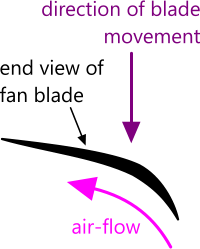
Fig 1. Fan Blade Airflow
There are a number of fan types: impeller, axial, centrifugal, Sirocco, etc. all of which have individual benefits (volume, pressure, speed, power, efficiency, etc.) but all of them will shift gases at the same rate based upon the input power. Differences such as efficiency or flow rate occur in the type of fan due to particular design advantages that favour one characteristic over another. For example, an impeller fan has a higher efficiency when transporting clean (light air) at high flow rates (high speed), whereas a straight-bladed Sirocco fan is more efficient when propelling heavy gases (vapours and particulates) because centrifugal force is the dominant driver. Multi-stage fans are normally used to increase outlet pressure, but are comparatively expensive.
Airflow through the impeller is generated by rotating profiled blades (Fig 1) in a cowling that cut into the air at their inlet tip pushing the air back along the blade and, in the case of centrifugal fans, also from centrifugal forces generating a partial vacuum on the inlet side of the fan due to the entrained air being thrown outwards according to the relationship a = v²/r
Apart from the electrical and mechanical components, the efficiency of a fan is to a large extent dependent upon the shape and orientation of the blades. All fans of a given power rating will rotate at a speed commensurate with the air resistance, i.e. the lower the air resistance, the faster the rotation and the greater the flow.
Multi-stage fans are used where a very high outlet pressure is required. I.e. each fan in the sequence increases pressure over the previous fan until you have achieved the pressure required. One normal axial fan operating at maximum efficiency can achieve a velocity pressure (pᵥ) of up to 0.5psi (≈3,500N/m²). A high-efficiency, multi-stage (series of fans) turbo-blower can achieve pressures more than a hundred times greater.
Generic Fans
CalQlata has tried to keep the operation of this calculation option as simple as possible, given that it is recommended for general purpose calculations only and not for actual purchase specifications (see Fan Calculator – Technical Help below).
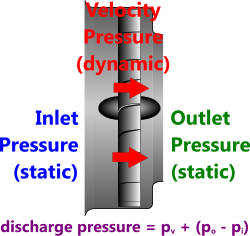
Fig 2. Fan Air Pressures
Fig 2 shows the pressures through a fan, each of which is described below:
Inlet Pressure; is the static pressure on the inlet side of the fan. This should also include the velocity pressure on the inlet side (if known) that is constant and in-line with the fan. You can include this effect if you wish by using the following formula:
pᵢ = pᵢ ± ½.v².ρᵢ {use '+' if the direction of movement is towards the fan and '-' if it is moving away from the fan (which is an unlikely event given the suction direction)}
Outlet Pressure; is the static pressure on the outlet side of the fan. This should also include the velocity pressure on the outlet side (if known) that is constant and in line with the fan as well as the velocity pressure (pᵥ) generated by the fan. You can include this effect if you wish by using the following formula:
pₒ = pₒ ± ½.v².ρₒ {use '+' if the direction of movement is towards the fan and '-' if it is moving away from the fan}
Velocity Pressure; is the pressure generated by the gas moving through the fan
Discharge Pressure; is the sum of the velocity pressure and the difference between the outlet pressure and the inlet pressure (Fig 2)
Static Pressure; is the maximum of the inlet and outlet pressures
Pressure Head; is the head generated by the discharge pressure at the outlet side of the fan
Fan Blade Design (Axial and Centrifugal)
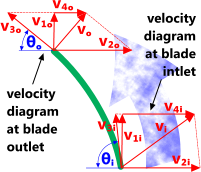
Fig 3. Air Velocity Diagram
The shape of your blades and the direction they travel will define the performance characteristics of your fan.
Fig 3 shows the velocity diagram for the air flowing into the fan (inlet) and out of it (outlet).
v₁ᵢ and v₁ₒ: the inlet and outlet velocities of the air through the blades will be the same for axial fans and different for centrifugal fans
v₂ᵢ and v₂ₒ: the circular speed of the inlet and outlet edges of the blade will be the same for axial fans and different for centrifugal fans
v₃ᵢ and v₃ₒ: the speed of the air over the surface of the blade will vary from inlet to outlet for both axial and centrifugal fans
v₄ᵢ and v₄ₒ: the centrifugal velocity component of the air will be zero for the inlet edge of an axial fan blade and will vary from inlet to outlet for both axial and centrifugal fans
vᵢ and vₒ: the absolute velocity of the air at the inlet and outlet edges of the blade and will vary from inlet to outlet for both axial and centrifugal fans
The following table summarises the characteristics you can expect from your fan dependent upon the shape of its blades (Fig 3).
| Characteristic | Backward Facing { )→ } | Straight { |→ } | Forward Facing { (→ } |
|---|---|---|---|
| Speed | high | medium | low |
| Noise | medium | high | low |
| Pressure | high (20" to 40" WG) | medium (8" to 15" WG) | Low (3" to 6" WG) |
| Volume Flow | medium | low | high |
| Particulates | good | excellent | poor |
| Efficiency | 80% x FF65% | 70% x FF45% | 70% x FF40% |
| Construction | heavy | medium | light |
Please bear in mind that the backward-straight-forward relationship refers to the inlet tip of the impeller blade (0° < θᵢ < 180°)
It is inadvisable to significantly orientate the outlet tip of an impeller blade in a forward direction (θₒ > 110°) as it would disrupt airflow and give unreliable results.
Efficiency
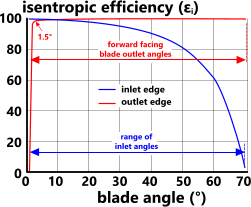
Fig 4. Axial Fan Efficiency
Whilst a fan's efficiency is not the only consideration for a designer, performance being his/her primary concern, it should not be ignored. Therefore, having achieved the design requirements, the designer should then proceed to optimise operational efficiency.
A fan's operational efficiencies are primarily dependent upon two factors; blade tip angles and mechanical/electrical equipment. The fan calculator addresses only the blade angles. Mechanical/electrical efficiency must be dealt with by the designer when selecting suitable materials and drive systems. The head losses generated by the blade tip angles (inlet and outlet) define a fan's 'air' efficiencies.
These losses are as follows ...
Shock (Lˢ): The air entering a centrifugal impeller changes direction from v₁ᵢ to vᵢ producing a shock load on the blade. The leading (inlet edge) angle can be set to eliminate this shock resulting in v₄ᵢ=0. This loss does not apply to axial fans; i.e. Lˢ=0
Friction (Lᶠ): The air passing over the surface of the blade (v₃ᵢ to v₃ₒ) will slow down as a result of friction between the air and blade.
Energy (Lᵉ): Air leaving the impeller of a centrifugal fan contains stored energy that is not converted into head or velocity. This loss does not apply to axial fans; i.e. Lᵉ=0
... which is largely determined by the leading and trailing blade angles.
As long as the cross-sectional area of a fan's diffuser (outer casing; Ac) is greater than the surface area of the outside diameter of the impeller (A or Ao for axial and centrifugal respectively), the fan will exhaust 100% of volumetric flow with the same pressure variation as generated by the impeller (δp). As the diffuser area is reduced, the flow-rate will fall and outlet pressure will increase.
Axial Fans
Axial fans only operate with inlet and outlet angles between 0° and 90° and the outlet angle must be greater than the inlet angle (Fig 3). Moreover, as can be seen in Fig 4, the inlet angle should be as small as possible and there is little to be gained by providing an outlet angle less than 90°
Efficiency varies slightly with impeller diameters (Øᵢ and Øₒ) and operating speed (N) but not with fan length (ℓ).
Centrifugal Fans
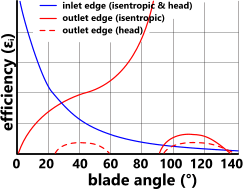
Fig 5. Centrifugal Fan Efficiency
As shown in Fig 5, except for very specific performance requirements, there is little to be gained in designing a centrifugal impeller with blade tip angles greater than 90°.
For general applications, maximum isentropic efficiency will be achieved by selecting small inlet angles and large outlet angles, however, this will be at the expense of head efficiency. Optimum efficiencies (head and isentropic) generally occur when inlet and outlet blade tips are set at angles around 45°.
Efficiency at these (optimum) angles varies with impeller diameters (Øᵢ and Øₒ) but is unaffected by variations in operating speed (N).
Axial vs Centrifugal
A comparison between the efficiency and performance of equivalent Axial and Centrifugal impellers is provided below ...
Axial:
ε = 100%; H = 15.5m; P = 268W; δp = 202Pa
Centrifugal:
ε = 74.4%; H = 14.3m; P = 322W; δp = 181Pa
... making the axial fan more efficient, primarily due to the negligible losses from shock and outlet energy that are always present and need to be optimised in centrifugal fans.
Aspect Ratio
CalQlata defines the aspect ratio (ф) of an impeller thus: ф = ID/OD
The radial depth of a high aspect ratio (0.75<ф<1.0) impeller is relatively shallow compared with its OD
High aspect ratio impellers are used for high-pressures and low flow rates (small impeller volume). However, the flow rate in wide high aspect ratio impellers can be improved by matching the shape of the input orifice to that of the impeller's cross-section
The radial depth of a medium aspect ratio (0.5<ф<0.75) impeller is relatively high compared with its OD. Such impellers provide greater flow rates but reduced pressure potential
Centrifugal fans are normally fitted with impeller aspect ratios greater than 0.5
Axial fans are normally fitted with impeller aspect ratios less than 0.5 (where flow is of greater importance than pressure)
Irrespective of design criteria, an impeller's aspect ratio should ensure that its airflow is not compromised. With particular regard to centrifugal fans; the impeller inlet area should be no less than the inlet area of the blades; π.Øᵢ²/4 ≥ π.Øᵢ.w.
Impeller ID
It is important to ensure that the inlet diameter of your centrifugal impeller is sufficient given the available inlet pressure (ambient or artificial) for the desired outlet mass or volumetric flow rate.
For example; an impeller of 0.5m diameter with an ID of 0.1m will never achieve the flow rate for which the impeller OD is capable unless the inlet pressure/flow-rate is artificially increased.
How Many Blades?
The number of blades (in your impeller) does not affect Fans' calculation results.
I.e. it is entirely up to you as to how many blades you use in your impeller.
Fans' calculations are based upon all the entrained air passing through the impeller with each rotation, which is normal practice for optimum blade configurations.
However:
Too few blades; the air trailing each blade will be turbulent, reducing operational efficiency. I.e. your fan will not actually achieve the desired/calculated flow-rate and/or pressure.
Too many blades will also reduce fan efficiency through increased skin friction and impeller mass (i.e. greater operational power).
A few rules:
1 Blade: Airflow will occur according to our calculations for about 1/3rd of the impeller volume, the rest of the air within the impeller will be turbulent making your fan extremely inefficient. Such a configuration is also difficult to balance.
2 Blades: Significantly improved airflow characteristics than one blade designs but still generates significant turbulence (behind each blade). Blade balancing is easier to achieve than one blade designs.
3 Blades: Excellent for impellers with small aspect ratio (e.g. axial fans) and much simpler to balance than 1 and 2-Blade designs.
4 Blades: Better airflow than the 3-Blade configuration but 33% greater skin friction. Airflow improvement more than offsets losses from skin friction.
5 Blades: Best configuration for all medium aspect ratio impellers.
6 Blades: Losses from increased skin friction and mass begin to exceed airflow gains.
>6 Blades: A general rule for large aspect ratio impellers (ф > 0.75) is to set the straight-line distance between the internal tips (toes) of adjacent blades approximately equal to the depth (radial height) of each blade.
Skin friction has a greater effect on flow-rate than pressure in fast fans.
I.e. it is advisable to minimise the number of blades in high flow-rate fans.
However many blades you decide to install, you should ensure that they should not overlap
If you are considering a forward facing blade configuration for a centrifugal fan, you will need to increase the number of blades significantly over the above rules in order to ensure sufficient inlet velocity. Fans will not generate a result for forward facing configurations with insufficient blades.
Casing
A fan casing may be any shape or size as long as its inlet and outlet diffusers do not impede airflow beyond that intended by the designer.
For example; Fans does not consider the manufacturing quality of the impeller casing, nor does it consider internal bends or deformations affecting the flow-path.
Inlet Diffuser
For the purposes of this description; the inlet area of a diffuser is the orifice nearest (adjacent) to the impeller.
Unless the purpose of a fan is to generate suction, there is nothing to be gained by restricting inlet airflow. Therefore, the cross-sectional area of the inlet diffuser should be no less than that of the impeller blade inlet.
If the casing inlet includes a diffuser, it is normally considered advisable to taper the diffuser to minimise the effects of surface friction.
Outlet Diffuser
For the purposes of this description; the outlet area of a diffuser is the orifice furthest from the impeller.
It is normal practice to design the diffuser outlet to minimise airflow restriction. In this case, the outlet area should be no less than that of the impeller blades.
If the casing outlet includes a diffuser, it is normally considered advisable to taper the diffuser to minimise the effects of surface friction.
Where outlet airflow is to be restricted, this may be achieved by reducing the diffuser outlet area (there is little to be gained by increasing the diffuser outlet area). The relative areas (impeller:diffuser) will define the resultant head, pressure and velocity of the outflowing air; volumetric flow-rate will of course remain unchanged.
The Theory (a few tips)
The theory on which this calculator is based is usually credited to Charles Innes. It is now considered to be the industry standard and has stood the test of time since 1916.
It is based upon the velocity of air as it passes over the blade profile (Fig 3). Like all theories it requires you to follow a few basic rules. if you don't follow the rules, your fan won't work. This does not mean Innes' theory doesn't work, it means that the air will not flow over the fan correctly.
For example the theory assumes a smooth transition from inlet blade tip to outlet blade tip. The two blade tip angles define the profile of your blade. Charles Innes did not create the performance of air over a curved blade, he simply shows us how to calculate it.
If you get it wrong, the results will be meaningless, not just theoretically meaningless but practically also. Your impeller won't work.
For example:
1) Always try to use a backward facing blade where possible. It generates more head (pressure) and is much more efficient.
2) Paddle blades must be 90° inlet and outlet (not simply close to this value) as they do not drive the air using the blade profile, they drive air out through the impeller using centrifugal force and any other angle will create unnecessary back pressure
3) Always use inlet blade angles considerably less than 90°
4) When setting blade outlet angles greater than 90°, always set the inlet blade angle shallow enough to overcome inward thrust from the outlet tip. The greater the outlet blade angle the shallower must be the inlet tip angle. If you just alter the outlet angle without adjusting the inlet angle you will struggle to find a solution. This is a particularly sensitive calculation as pressure generation is already low; it doesn't take much to generate a negative pressure.
5) If you are getting negative results, this simply means that your head losses are greater than the head generated.
If you are getting negative results with blade outlet tip equal to 90°, it means that the theory is having a problem with the fan design. This problem can be overcome simply by altering the outlet angle to 89.99°.
Outlet blade angles greater than 90° will always give you a bit of a challenge to create a workable solution. The secret here is to ensure that inlet angle is very shallow (e.g. << 45°; i.e. a deep cup-shape blade) to generate the inlet pressure required to overcome the negative pressure at the outlet. Moreover, it is advisable to minimise the number of blades used in such fans.
Fan Design Procedure
It is important to remember the following when designing a fan using the Axial and/or Centrifugal calculation options in our fan calculator:
The output results from Fans are for driving the air alone.
Power will increase with material mass & drive mechanism inefficiencies, and the head and flow rates will vary with casing design.
The drive system and casing irregularities are difficult to incorporate in a calculator as the possible variations are infinite.
Hence the need to follow a suitable procedure when designing your fan (a driven impeller within a casing).
1) List your operating parameters (flow-rate, head, pressure-rise, etc.)
2) Use Fans to size your impeller and set your blade angles. Output co-ordinates can be found in the Data Listing menu. Copy and paste into your spreadsheet for plotting (see Fig 8).
3) The power output (in Watts if you are entering Newtons and Metres) is that needed for movement of the air only.
Because power is calculated thus: P = 2.π.N.T and T = m.g.r, that required to spin your impeller can be linearly interpolated by factoring in the mass of the impeller.
For example; if your impeller material has 4 times the mass of the air entrained within it, the input power required to drive your fan will be 5 times greater than that calculated in Fans, added to which will be any power losses in the drive system.
It is usual to ensure that the inlet and outlet areas of the casing are the same as the inlet and outlet areas of the impeller. This will ensure that the flow and pressure expected from your fan will be similar to your impeller. However, frictional and directional losses from the casing invariably reduce output efficiency.
4) Input area of the impeller blades is π.Øᵢ.w
It is important to ensure that the impeller aspect ratio and diffuser inlet area is always larger than this to minimise frictional loss.
5) Output area of the impeller is π.Øₒ.w
The outlet area may be larger or smaller than this dependent upon your performance requirements. However, if the width of your casing outlet is narrower than the impeller, your fan's efficiency will suffer.
The blade-tip angles define a fan's performance. It is therefore necessary to play with these to achieve the desired results. For example:
Increasing the input blade-tip angle (θᵢ) will increase power consumption (P) and pressure variation (δp), but it will decrease flow rate (Q)
Increasing the output blade-tip angle (θₒ) will increase power consumption (P), pressure variation (δp) and flow rate (Q)
Moreover, a one-degree variation in blade tip angle will effect fan performance differently whether it is applied to the inner or outer edge of the blade.
Fan Calculator – Technical Help
Fans calculates the airflow through an impeller together with the expected effects a restricted casing diffuser would generate.
The fan calculator has been designed to enable you to specify a suitable product for your application, not (necessarily) to design a fan⁽¹⁾.
Units
You may use any units you like, but you must be consistent.
You should be careful when selecting your units as your gas constant (Rₐ) will dictate the units of mass and length for all your output results, i.e.;
If you are using metric units, you may find it simpler to use metres and kilograms and for Imperial calculations, you should find it easier to use feet and pounds (avoirdupois) as the gas constant is readily available in these units. You will find values for the appropriate constants (Rᵢ and g) in the Technical Help menu of the fan calculator.
Common Data
g is the acceleration due to gravity. This value must be set to 1 (one) if pᵢ is in units of mass per unit area such as kgf/m² or lbf/ft².
Generic
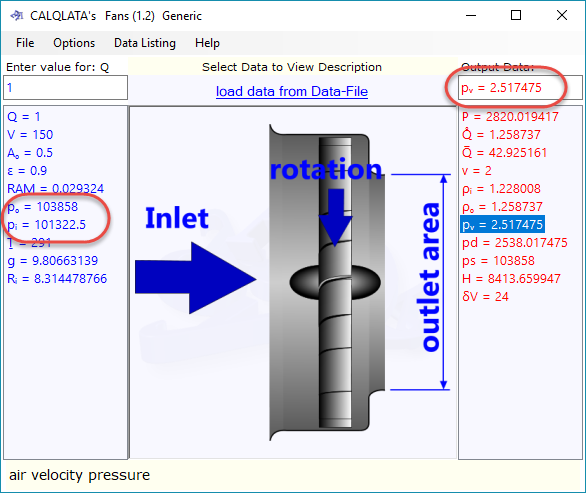
Selecting the correct values for inlet and outlet pressures will provide your greatest dilemma in these calculations. For example:
If you are extracting from a room in your house or office and you assume that the pressure inside and outside are both exactly at one atmosphere (101,325N/m²), the calculated power consumption of your fan will be considerably less than in reality. However, by charging the fan with air, it will naturally generate a localised vacuum at the inlet side, and the greater movement of air outside the fan will normally generate higher positive pressure than atmospheric for the fan to overcome.
Atmospheric pressure normally varies between 0.98 & 1.05 bar. You need not concern yourself with pressures lower than 1 bar as flow rates under such conditions will be achieved with less power input. 1.05 bar represents unusually high pressure and may be ignored for general applications.
CalQlata suggests that, unless you have actual or more accurate data for the pressure differentials between inlet and outlet you could estimate these pressures as follows (Fig 6):
pᵢ: Calculate the flow rate, setting the inlet and outlet pressures both equal at 101,322.5N/m². Then deduct the velocity pressure from the atmospheric pressure (pᵢ = pᵢ - pᵥ)
pₒ: Multiply atmospheric pressure by 1.025 (i.e. pₒ = 103858N/m²)
Input DataQ is the volumetric quantity of gas {m³} you want to shift through the fan every second. The fan calculator converts this value into mass flow rate {Q̊}, mole flow rate {Q̅} and linear velocity {v}.
V is the volume of a room or space that your fan must affect a gas-change rate (δV). You may ignore this value if you're not interested in determining the gas-change rate as this is the only calculation where it's used.
Aₒ is the cross-sectional area of the outlet side of the fan
ε is the efficiency of the fan (which is normally between 50% and 90% dependent upon gas and design). You may enter this value as a factor (e.g. 0.67) or a percentage value (e.g. 67). The fan calculator will recognise the correct value; i.e. you cannot have a factor>1.0 and Fans will assume that your fan will have an efficiency greater than 1%.
RAM is the relative atomic mass of the gas (e.g. air) passing through the fan
pᵢ and pₒ are pressures of the gas at the inlet and outlet sides of the fan respectively
Ṯ is temperature of the gas at both the inlet and outlet sides of the fan
Rᵢ is the ideal gas constant
Output DataP is the minimum power of the fan (e.g. Watts). If you need to include losses in addition to the efficiency of the fan (ε) you can incorporate them by multiplying the expected additional losses by the efficiency factor and entering the modified value for ε in the input data
Q̊ is the mass flow rate of gas through the fan
Q̅ is the mole flow rate of gas through the fan
v is linear velocity of the gas through the outlet aperture
ρᵢ and ρₒ are the input and output densities of the gas (respectively) passing through the fan
pᵥ is the velocity pressure of the gas passing through the fan, i.e. this pressure only exists in the moving gas
pd is the discharge pressure generated by the fan; i.e. the difference between the inlet and outlet pressures plus the velocity pressure
ps is the static pressure in the fan; i.e. the maximum of inlet and outlet pressure
h is the pressure head of the gas at the outlet side of the fan
δV is the volume change rate of the room volume (V)
Axial & Centrifugal (Blade Design)
This calculation option determines the airflow through impeller blades. It does not calculate a fan's mechanical efficiency.
In order to improve the airflow efficiency of a fan, you need to minimise the losses (Lˢ, Lᶠ, Lᵉ) and to do this you need to optimise the size and shape of the its blades.
You will find that some changes to input data reduce one loss but raise another so a little trial and error is required to maximise efficiency.
The only variables that need to be modified in a fan to improve its efficiency are listed below:
Axial Fans
In order to lower ...
Lᶠ: lower Øᵢ, Øₒ, N, θᵢ or raise θₒ
Raise θₒ to improve efficiency (ε)
Centrifugal Fans
In order to lower ...
set θᵢ to {θᵢ} for Lˢ = 0
Lᶠ: lower Øₒ, N and raise Øᵢ, θₒ
Lᵉ: lower Øᵢ, N, θₒ and raise Øₒ
In other words; increasing:
Øᵢ: lowers Lᶠ and raises Lᵉ
Øₒ: raises Lᶠ and lowers Lᵉ
N: raises Lᶠ and Lᵉ
θₒ: lowers Lᶠ and raises Lᵉ
N is the rotational speed of the fan blades in revolutions per minute
θᵢ⁽²⁾ is the angle of the inlet tip of the blade which can only be between 0° and 180°. If this angle is greater than 'θₒ' a warning will appear to increase the outlet angle
Note: angles greater than 90° will struggle to generate the inlet velocity required to initiate throughput. Even forward facing blades should have inlet angles <90° {'forward facing' refers to the outlet angle only}
θₒ⁽²⁾ is the angle of the outlet tip of the blade which can only be between 0° and 180°. If this angle is less than 'θᵢ' a warning will appear to increase its value
Øᵢ is inside diameter of the fan blades
Øₒ is outside diameter of the fan blades
ℓ is the length of the blades between the inlet and outlet edges in an axial fan
w is the width of the blades in a centrifugal fan, parallel to the axis of rotation of the impeller
ρᵢ is the density of the air at the inlet edge of the fan blades
pᵢ is the pressure of the air at the inlet edge of the fan blades
Ṯ is the temperature of the air at the inlet edge of the fan blades
Rₐ is the specific (or mass) gas constant
F is the coefficient of friction of air (with the blades). The generally accepted value for clean dry air is 0.125, but entrained water, particles and/or significant temperature variations can increase this value
γ is the ratio of specific heats (γ = cp/cv) which is used to calculate the isentropic efficiency (εᴵ)
{for air; γ ≈ 1.422}
n° is the number of blades in the impeller
Ac is the cross-sectional area of the casing diffuser
If this value is set greater than or equal to the impeller outlet area, pc, vc, ρc, Hc and Pc may be ignored as the casing outlet diffuser is expected to have no appreciable effect on fan performance.
Q is the volumetric flow rate (per hour) of air through the fan. Multiply this figure by the outlet density ('ρₒ') to find the mass flow rate (/hour).
It is important to note that this is the output rate of the impeller assuming no restrictions from the fan casing. If the fan outlet diffuser area is less than the surface area of the impeller outside diameter (Øₒ), this flow rate will not be achieved by the fan. A simple calculation procedure you may use to establish the output flow rate of the fan (impeller inside a casing) is provided in the calculators technical help menu.
T is the torque required to rotate the blades through the air at the speed (N) required for a free-flowing impeller. This figure will be higher for an impeller in a casing (i.e. a fan)
P is the power required to drive the torque (T)
δp is the change in pressure from inlet to outlet
ρₒ is the density of the air leaving the fan
Hᵀ is the pressure-head of the fan before removing the effect of the operational losses (Lˢ, Lᶠ, Lᵉ)
Lˢ is the loss of head due to the air changing direction as it enters the fan. This value is zero for axial fans and sometimes ignored in head (H) and efficiency (ε) calculations for centrifugal fans.
Lᶠ is the loss of head due to friction between the air and blades.
Lᵉ is the loss of head from the stored energy in the air leaving the fan. This value is zero for axial fans.
H is the pressure-head of the fan after removing the effect of the operational losses (Lˢ, Lᶠ, Lᵉ)
εᴴ is the efficiency of the airflow through the fan based upon the loss of head (excluding mechanical efficiency)
ε is the efficiency of the airflow through the fan based upon the loss of head, ignoring loss due to inlet shock (Lˢ) (excluding mechanical efficiency)
εᴵ is the isentropic efficiency of the airflow through the fan
vᵢ is the absolute velocity of the air at the inlet edge of the blades
vₒ is the absolute velocity of the air at the outlet edge of the blades
v₁ᵢ is the axial (AXIAL FANS) or radial (CENTRIFUGAL FANS) velocity of the air at the inlet edge of the blades. This value is equal to 'v₁ₒ' in axial fans
v₁ₒ is the axial (AXIAL FANS) or radial (CENTRIFUGAL FANS) velocity of the air at the outlet edge of the blades. This value is equal to 'v₁ᵢ' in axial fans
v₂ᵢ is the velocity inlet side of the blades. This value is equal to 'v₂ₒ' in axial fans
v₂ₒ is the velocity outlet side of the blades. This value is equal to 'v₂ᵢ' in axial fans
v₃ᵢ is the velocity of the air passing over the blades at the inlet edge of the blades
v₃ₒ is the velocity of the air passing over the blades at the outlet edge of the blades
v₄ᵢ is the rotational velocity component of the air at the inlet edge of the blades (this value is zero for axial fans)
v₄ₒ is the rotational velocity component of the air at the outlet edge of the blades
Axial Impeller Outlet Area:
A is the airflow area through the blades of an axial impeller
Centrifugal Impeller Outlet Area:
Ar is the ratio of inlet and outlet areas (Ai:Ao)
Ai is the airflow inlet area through the blades of a centrifugal impeller
Ao is the airflow outlet area through the blades of a centrifugal impeller
Common Output Data (immediately prior to outlet diffuser of the fan casing):
pc is the expected air pressure
vc is the expected air velocity
ρc is the expected air density
Hc is the expected head
Pc is the expected power required to drive air through the outlet casing diffuser (incl. impeller)
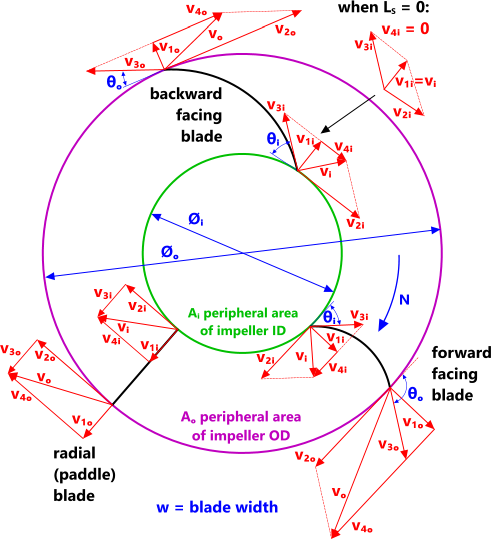
Fig 7. Air Velocity Diagram (Centrifugal Fans)
Centrifugal Fans (calculation hints)
Fig 7 is a breakdown of air velocities for each of the three available blade configurations.
When planning the design of a centrifugal fan, it is important that you begin by selecting the most suitable blade type for your purposes. As mentioned above, there are pros and cons for each configuration; pressure, flow, efficiency, noise, etc.
Within limits, and excluding efficiencies and losses, almost any throughput can be achieved with any of the configurations available.
The following is provided to offer some help with your calculations:
For example; the ebm fan pictured below (Fig 8), calculations show that both forward and backward-facing (in parenthesis) blades may be configured to generate similar performance characteristics in a fan of similar dimensions. The results are not exact because the blade angles, air properties and constants used by the manufacturer are unknown. CalQlata has been forced to guess the input data to get as close as possible to the manufacturer's results.
One important thing to remember when designing a fan with forward-facing blades is that the leading (internal) edge should always be less than 90°.
Whilst it can be difficult to recalculate a manufacturer's working fan if most of the input data is unknown, it can be reproduced by playing with the blade tip angles (θᵢ & θₒ).
A little bit of advice; follow the sequence below;
1) set the inside tip angle at 80°,
2) play with the outside tip angle until you achieve reasonable results,
3) fettle both tip-angles (inside and outside) to finalise your results.
The two calculation examples in Fig 8 both took the same time to reproduce (5-minutes), but the backward-blade calculation was easier to match in the time allotted.
Note: excessive blade angles in forward facing blades will quickly cause any fan (and its calculations) to fail; backward facing blade configurations are far more robust.
Application
This calculator is suitable as a close approximation (see Accuracy below) calculation tool for any and all extraction and compression calculations in atmospheric and/or ducting systems. CalQlata recommends that final design calculations should be made on the basis of specifications and procedures recommended by your selected supplier.
Accuracy
Designers with little or no experience with fans should be aware that reliable output data from Fans is very much dependent upon the accuracy of your input data. If all input data is correct and accurate, there is no expected error margin in the results.
As can be seen in Fig 8; the following input data produces comparable results with a data-sheet issued by a prominent manufacturer for one of its fans:
impeller speed: N = 2685 {RPM}
blade inlet angle: θᵢ = 78.5 (79) {°} #
blade outlet angle: θₒ = 134.6 (41) {°} #
impeller inside diameter: Øᵢ = 0.1315 {m}
impeller outside diameter: Øₒ = 0.16 {m}
impeller width: w = 0.0616 {m}
air density at impeller inlet: ρᵢ = 1.2 {kg/m³}
air pressure at impeller inlet: pᵢ = 101325 {Pa}
air temperature at impeller inlet [absolute]: Ṯ = 293 {K}
gravitational acceleration: g = 9.80663139 {m/s²}
specific gas constant (air): Rₐ = 283.5383565 {J/K/kg}
frictional resistance coefficient (air): Cᶠ = 0.14
ratio of specific heats (cp/cv) {air: γ = 1.4226}: γ = 1.4226
number of blades in the impeller: nᵒ = 40
# blade angles: forward facing (backward facing). See Calculations above
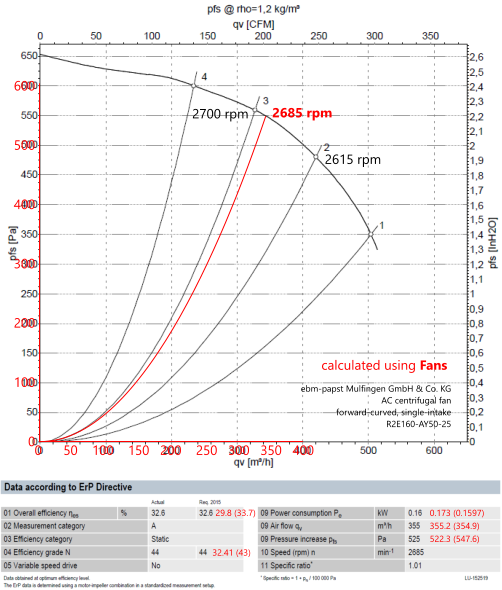
The minor differences are due to the lack of information available, such as blade angles and atmospheric properties, in the data-sheet concerned. These values have therefore been estimated for the Fans calculation. However, the results are sufficient to validate Charles Innes' theory, on which Fans is based.
Notes
- Every manufacturer's product will differ in terms of performance and specification to every other manufacturer. You should therefore apply the relevant performance specification of your preferred supplier's product to your final design as opposed to your design requirements.
- This theory does not like angles of exactly 90°. You should use 89.5° or 90.5° for such an angle
Further Reading
You will find further reading on this subject in reference publications(3 & 12)

